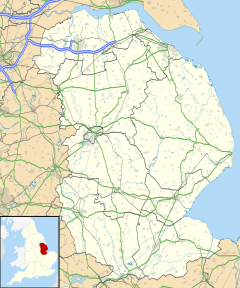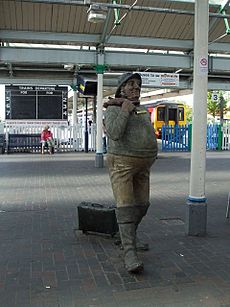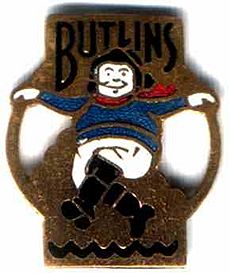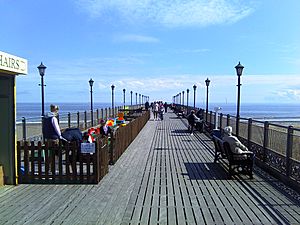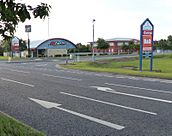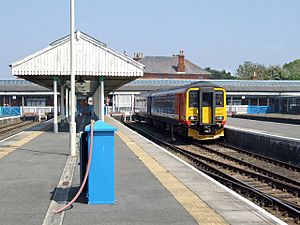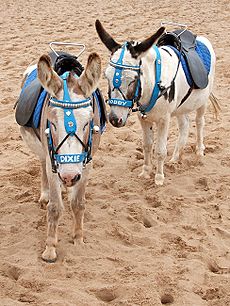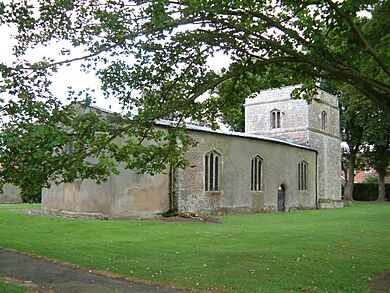Skegness facts for kids
Quick facts for kids Skegness |
|
|---|---|
| Town | |
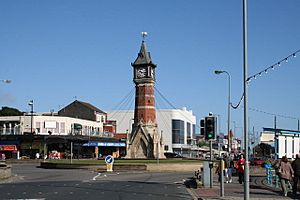 Skegness clock tower and seafront amusements |
|
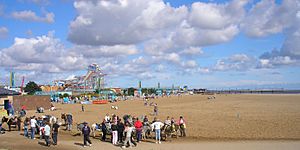 The beach with the pier in the background |
|
| Population | 21,128 (2021 Census) |
| OS grid reference | TF5663 |
| • London | 115 mi (185 km) S |
| Civil parish |
|
| District | |
| Shire county | |
| Region | |
| Country | England |
| Sovereign state | United Kingdom |
| Post town | SKEGNESS |
| Postcode district | PE24, PE25 |
| Dialling code | 01754 |
| Police | Lincolnshire |
| Fire | Lincolnshire |
| Ambulance | East Midlands |
| EU Parliament | East Midlands |
| UK Parliament |
|
Skegness (/ˌskɛɡˈnɛs/ skeg-NESS) is a seaside town and civil parish in the East Lindsey District of Lincolnshire, England. On the Lincolnshire coast of the North Sea, the town is 43 miles (69 km) east of Lincoln and 22 miles (35 km) north-east of Boston. With a population of 21,128 as of 2021, it is the largest settlement in East Lindsey. It incorporates Winthorpe and Seacroft, and forms a larger built-up area with the resorts of Ingoldmells and Chapel St Leonards to the north. The town is on the A52 and A158 roads, connecting it with Boston and the East Midlands, and Lincoln respectively. Skegness railway station is on the Nottingham to Skegness (via Grantham) line.
The original Skegness was situated farther east at the mouth of The Wash. Its Norse name refers to a headland which sat near the settlement. By the 14th century, it was a locally important port for coastal trade. The natural sea defences which protected the harbour eroded in the later Middle Ages, and it was lost to the sea after a storm in the 1520s. Rebuilt along the new shoreline, early modern Skegness was a small fishing and farming village, but from the late 18th century members of the local gentry visited for holidays. The arrival of the railways in 1873 transformed it into a popular seaside resort. This was the intention of The 9th Earl of Scarbrough, who owned most of the land in the vicinity; he built the infrastructure of the town and laid out plots, which he leased to speculative developers. This new Skegness quickly became a popular destination for holiday-makers and day trippers from the East Midlands factory towns. By the interwar years the town was established as one of the most popular seaside resorts in Britain. The layout of the modern seafront dates to this time and holiday camps were built around the town, including the first Butlin's holiday resort which opened in Ingoldmells in 1936.
The package holiday abroad became an increasingly popular and affordable option for many British holiday-makers during the 1970s; this trend combined with declining industrial employment in the East Midlands to harm Skegness's visitor economy in the late 20th century. Nevertheless, the resort retains a loyal visitor base. Tourism increased following the recession of 2007–09 owing to the resort's affordability. In 2011, the town was England's fourth most popular holiday destination for UK residents, and in 2015 it received over 1.4 million visitors. It has a reputation as a traditional English seaside resort owing to its long, sandy beach and seafront attractions which include amusement arcades, eateries, Botton's fairground, the pier, nightclubs and bars. Other visitor attractions include Natureland Seal Sanctuary, a museum, an aquarium, a heritage railway, an annual carnival, a yearly arts festival, and Gibraltar Point nature reserve to the south of the town.
Despite the arrival of several manufacturing firms since the 1950s and Skegness's prominence as a local commercial centre, the tourism industry remains very important for the economy and employment but the tourism service economy's low wages and seasonal nature, along with the town's aging population, have contributed towards high levels of relative deprivation. Poor transport and communication links are barriers to economic diversification. Residents are served by five state primary schools and a preparatory school, two state secondary schools (one of which is selective), several colleges, a community hospital, several churches and two local newspapers. The town has a police station, a magistrates' court and a lifeboat station.
Contents
Geography
Longshore drift carries particles of sediment southwards along the Lincolnshire coast; at Skegness, the sand settles out in banks which run at a slight angle to the coast. The slightly elevated dune land sheltered the small natural harbour which the Danes found behind the banks. The finer sediment drifts on to reach the mud of the Wash, beyond Gibraltar Point.
The civil parish extends westwards along the A158 to the west side of the South View Hotel, and the boundary follows North Drain, bordering Burgh le Marsh. Just north of Mill Hill it borders Addlethorpe, passing to the west of Ash Tree Farm, the airfield and Skegness Water Leisure Park. At the north end of the leisure park it borders Ingoldmells, and the boundary follows to the south of Wall's Lane. The boundary crosses the A52 at a subway across the road, just south of the Butlin's camp. To the south of the hotel on the A158, the parish follows Main Drain, to the west of Warth Lane. Just south of Ivy House, it crosses the A52 and borders Croft. The boundary follows Cow Bank Drain, over a level crossing, to the north of Croft Grange, then passes through Bramble Hills, just north of Seacroft Golf Course to the sea.
Skegness is on the drier eastern side of Britain: this is often used in promoting it as a holiday resort.
History
Early history
The name indicates that Skegness has its origin in the Danish period of settlement of England although there is no reference to a village named Skegness in the Domesday Book. The town's name means either "Skeggi's headland" or "beard-shaped headland" (possibly referring to the banks at an angle to the coast). Skeggi(meaning "bearded one"), may have been one of the Vikings who established the original settlement to the east of the current town which was washed away by the sea in the early 16th century; or the Old East Norse word skegg "beard".
Lying within the historic county boundaries of Lincolnshire from a very early time, the parish of Skegness was in the Marsh division of the ancient Wapentake of Candleshoe in the Parts of Lindsey.
In August 1642, a consignment of arms and money, probably raised by Queen Henrietta Maria in the Netherlands to support King Charles I's campaign in the civil war, was forced into Skegness by the ships of the Parliamentarian Earl of Warwick.
Railway
Skegness was primarily a fishing village and small port, and significant numbers of visitors were not seen before the arrival of the railway in 1875. In 1908, the Great Northern Railway commissioned a poster to advertise excursions to the resort: the first such excursion was from King's Cross, London on Good Friday 1908, leaving London at 11.30 am. The "Skegness is so Bracing" poster featuring the Jolly Fisherman helped to put Skegness on the map and is now famous. The poster, derived from an oil painting by John Hassall, was purchased by the railway company for 12 guineas (£12.60). However Mr Hassall did not visit the resort until 1936. He is said to have died penniless. Skegness is now served by an East Midlands Trains service from Nottingham via Grantham.
Resort town and Butlin's
Most of the land in the modern centre of Skegness formed part of the estate of the Earl of Scarbrough. He and agent H. V. Tippet realised that the extensive sandy beach could be made attractive to holidaymakers from the industrial towns of the Midlands, a clientele already developed by Thomas Cook. He planned the town as a resort from 1877 and it expanded rapidly, but along with many other UK resorts, especially those on the cold North Sea, it lost out to the cheap package holiday boom which opened up Spain (in particular) to the average holidaymaker, especially when currency restrictions were lifted in the 1970s and travellers could leave the UK with more than 65 pounds.
Ingoldmells, the parish to the north of Skegness, was the site of the UK's first holiday camp, started by Billy Butlin in 1936. Butlins is still there today, at the north end of the town, on the road to Ingoldmells. It maintains its appeal as a destination for family holidays, and attracts thousands to the resort in the low season with music weekends encompassing '60s, '80s, soul and other genres.
The Wash incident
The Wash incident took place in the early hours of 5 October 1996 when a "strange red and green rotating light" was seen by Skegness residents and police officers to the southeast of Skegness, who then contacted the Coastguard at Great Yarmouth. It later involved many RAF stations, including RAF Neatishead, and GCHQ. The object was probably not an aircraft because although it could be seen on radar, it had no transponder. The Skegness News, a local newspaper which no longer exists, investigated the incident and sought confirmation of the object from the Jodrell Bank Observatory. In their report to the RAF, the observatory said that Venus, "the queen of UFOs", which had been shining with exceptional brilliance in the early morning sky to the east, probably explained the light shown on the video. The object was caught on video by Skegness Police. The RAF decided the stationary blip was a permanent echo of the 272 ft tall St Botolph's Church, Boston, and the object on the video was the planet Venus.
Present day
In March 2005, Skegness took the top spot in a survey by Yours magazine, looking at the best retirement places in the UK. Yours researchers visited sixty likely towns. The factors involved in judging included house prices, hospital waiting lists, the crime rate, council tax rates, activities and attractions, weather patterns and ease of transport. Skegness has also been described by Lonely Planet's Great Britain guide as "everything you could want" in a seaside resort. On 22 July 2008 the newly elected Mayor of London, Boris Johnson, caused controversy in an article in the Daily Telegraph, where he declared "Stuff Skegness, my trunks and I are off to the sun", in his desire to have a foreign holiday that year.
Economy
According to VisitEngland, in 2011 Skegness was the fourth most popular holiday destination in England among UK residents. In 2015, Skegness and Ingoldmells received 1,484,000 visitors, of which 649,000 were day visitors; this brought in £212.83 million in direct expenditure, with an estimated economic impact of £289.60 million. The town council has described local employment as "heavily reliant" on tourism. One estimate suggested that in 2015 2,846 jobs were supported directly by the visitor economy (accounting for around a third of the town's employed residents), with tourism indirectly supporting nearly 900 more. Over half of these jobs were in accommodation and food and drink, with a further 18.1% in retail. Skegness's visitor economy has been described by the district council as "counter-cyclical"; while continuing to serve a loyal client base, it provides a cheap alternative to holidays abroad and has therefore proven popular when the economy has been slower for the rest of the region. The seafront is a hub for the tourism industry, much of which is geared towards the provision of food (most famously fish and chips), amusement arcades and other attractions, including the Botton's Pleasure Beach funfair. The pubs, bars and nightclubs, and neon-lit amusements have earned it the nickname "Skegvegas" (after Las Vegas).
Before the 1950s, the only major manufacturing interest in Skegness was Alfred Hayward's rock factory which had opened in the 1920s. After the Second World War, some other light industry arrived, including Murphy Radio and the nylon makers Stiebels; in 1954 the bearings and packaging systems manufacturer Rose Brothers (Gainsborough) Ltd opened a factory on Church Road in a former laundry. The urban district council opened an industrial estate off Wainfleet Road in 1956 which Murphy and Stiebels moved to. Murphy's successor left the town in the 1970s, but Stiebels and the ride manufacturer R. G. Mitchell were still operating on the estate in the late 1980s, while Rose-Forgrove (which had opened a larger factory in 1977) and Sanderson Forklifts had factories elsewhere in the town. The latter went into administration in 1990, and the Rose Bearings factory was sold to NMB-Minebea in 1992; they closed it in 2010. The ride manufacturer R. G. Mitchell was purchased in 2005 by Photo-Me International; operation resumed under the name Jolly Roger Amusement Rides, which continues to operate on the industrial estate as of 2020. According to Google Maps, in 2020 there were three other manufacturers operating on the industrial estate: Unique Car Mats (UK) Ltd (founded in 1989), Windale Furnishings Ltd (a caravan seating maker founded in 1993), and Parragon Rubber Company. A range of services have outlets on the estate, including a medical practice, two skilled trades, a solicitor, five vehicle repair garages, three other repair services and a mobile disco. There is also a recycling centre and driving test centre; 16 shops ranging from a cheesemonger to tyre dealers; 12 wholesalers in electrics, building materials, plumbing and hardware supply, and 11 other wholesalers in fields including clothing, restaurant equipment, meat and plastic sheeting. The district council have proposed extending the estate as of 2016. The council also opened the Aura Skegness Business Centre there in 2004.
Along with Louth, Skegness is "one of the main shopping and commercial centres" in East Lindsey, most likely due to it being the closest service hub for a large part of the surrounding rural area. Management Horizon Europe's 2008 UK shopping index measured the presence of national suppliers; Skegness was the highest ranked shopping destination in the district. It also ranked highest in the 2013–14 Venuescore survey. The High Street and Lumley Road are key retail areas, along with the Hildreds Centre (a small shopping mall which opened in 1988), Skegness Retail Park (developed between 2000 and 2005), and the Quora Retail Park on Burgh Road which opened in 2017 and includes several supermarkets; other supermarkets operate elsewhere. Occupancy rates are relatively high: in 2015, 4% of ground-floor retail units were vacant, which is less than half the national average and down from 9% in 2009. Nevertheless, Skegness is relatively weak at offering higher value comparison goods, with Lincoln and Grimsby being key destinations for high-value shopping.
Demography
| Population changes of Skegness (Civil Parish) | |||||||||||||||||||||||||||||||||||||||||||||||||||||||||||||||||||||||||
|---|---|---|---|---|---|---|---|---|---|---|---|---|---|---|---|---|---|---|---|---|---|---|---|---|---|---|---|---|---|---|---|---|---|---|---|---|---|---|---|---|---|---|---|---|---|---|---|---|---|---|---|---|---|---|---|---|---|---|---|---|---|---|---|---|---|---|---|---|---|---|---|---|---|
|
|
||||||||||||||||||||||||||||||||||||||||||||||||||||||||||||||||||||||||
Population change
The poll tax returns for 1377 recorded 140 people living in Skegness over the age of 14; in 1563 there were 14 households, and in the late 17th century there were ten families. The first census of the parish was conducted in 1801 and recorded a population of 134. It had risen above 300 by 1841 and reached 366 ten years later, before dropping back to 349 in 1871. Following the initial development of the seaside resort, the population rose rapidly, contracted in the 1880s and then rose sharply so that by 1921 the resident population was over 9,000. This figure reached 12,539 in 1951, and continued to rise at varying rates over the century. It had reached 18,910 in 2001 and 19,579 in the 2011 census. As designated by the Office for National Statistics, the Skegness built-up area incorporates the contiguous conurbation extending north through Ingoldmells to Chapel St Leonards; this had a population of 24,876 in 2011 which makes it the largest settlement in the East Lindsey district (followed by Louth) and represents about 18% of the district's population.
Ethnicity and religion
According to the 2011 census, Skegness's population was 97.6% White; 1% Asian or British Asian; 0.4% Black, African, Caribbean or Black British; and 0.9% mixed or multi-ethnic; and 0.1% other. The population is therefore less ethnically diverse than England as a whole. 94.2% of the town's population were born in the United Kingdom, compared with 86.2% nationally; 3.5% were born in European Union countries other than the UK and Ireland, of which more than three quarters (2.7% of the total) were born in post-2001 accession states; for England, the figures were 3.7% and 2.0% respectively. 1.8% of the population was born outside the EU, whereas the total for England was 9.4%.
In the 2011 census, 68.2% of Skegness's population said they were religious and 24.9% said they did not follow a religion, very similar to England as a whole (68.1% and 24.7% respectively). However, compared to England's population, Christians were a higher proportion of the Skegness population (66.8%), and all other groups were present at a lower proportion than the national rates. There were 8 Sikhs in Skegness, making up a negligible proportion of the population compared with 0.8% nationally; Hindus composed 0.1% (compared with 1.5% in England), Muslims 0.5% against 5% nationally, Jewish people 0.1% compared with 0.5% for all of England, and Buddhists 0.2% of the town's population, contrasting with 0.5% nationally.
| Ethnicity, nationality and religious affiliation of residents (2011) | |||||||||||||
|---|---|---|---|---|---|---|---|---|---|---|---|---|---|
| White | Asian or British Asian | Black, African, Caribbean or Black British | Mixed or multi-ethnic | Other ethnicity | Born in UK | Born in EU (except UK and Ireland) | Born outside EU | Religious | Did not follow a religion | Christian | Muslim | Other religions | |
| Skegness | 97.6% | 1.0% | 0.4% | 0.9% | 0.1% | 94.2% | 3.5% | 1.8% | 68.2% | 24.9% | 66.8% | 0.5% | 0.4% |
| England | 85.4% | 7.8% | 3.5% | 2.3% | 1.0% | 86.2% | 3.7% | 9.4% | 68.1% | 24.7% | 59.4% | 5.0% | 2.5% |
Workforce and deprivation
| Economic characteristics of residents aged 16 to 74 (2011) | ||
|---|---|---|
| Characteristic | Skegness | England |
| Economic activity | ||
| Economically active | 60.0% | 69.9% |
| Employed | 51.7% | 62.1% |
| Full-time employed | 27.7% | 38.6% |
| Retirees | 21.7% | 13.7% |
| Long-term sick or disabled | 7.9% | 4.0% |
| Long-term unemployed | 2.3% | 1.7% |
| Industry | ||
| Manufacturing | 7.1% | 8.8% |
| Construction | 6.9% | 7.7% |
| Wholesale and retail trade; repair of vehicles | 21.2% | 15.9% |
| Transport and storage | 4.3% | 5.0% |
| Accommodation and food services | 17.3% | 5.6% |
| Information and communication | 0.6% | 4.1% |
| Financial and insurance | 0.8% | 4.4% |
| Professional, scientific and technical | 2.8% | 6.7% |
| Public administration and defence | 3.6% | 5.9% |
| Education | 7.3% | 9.9% |
| Health and social work | 11.7% | 12.4% |
| Occupation | ||
| Managers and directors | 12.9% | 10.9% |
| Professionals; associate professionals | 13.9% | 30.3% |
| Administrative and secretarial | 8.4% | 11.5% |
| Sales and customer services | 12.1% | 8.4% |
| Caring, leisure and other services | 12.2% | 9.3% |
| Skilled trades | 12.9% | 11.4% |
| Process, plant and machine operatives | 8.9% | 7.2% |
| Elementary occupations | 18.9% | 11.1% |
| Qualifications | ||
| No qualifications | 40.8% | 22.5% |
| Level 4 or higher | 10.7% | 27.4% |
In 2011, 60% of Skegness's residents aged between 16 and 74 were economically active, compared with 69.9% for all of England. 51.7% were in employment, compared with 62.1% nationally. The proportion in full-time employment is comparatively low, at 27.7% (against 38.6% for England). The proportion of retirees is higher, at 21.7% compared with 13.7% for England. The proportion of long-term sick or disabled is 7.9%, nearly double England's 4%; 2.3% of people were long-term unemployed, compared with 1.7% in all of England. The 2011 census revealed that the most common industry residents worked in were: wholesale and retail trade and repair of motor vehicles (21.2%), accommodation and food services (17.3%), and human health and social work (11.7%). The proportion of people employed in accommodation and food services was over three times the national figure (5.6%), while the proportion working in wholesale and retail trade and vehicle repair was also higher than in England as a whole (15.9%). Most other industries were under-represented comparatively, with both financial services (0.8% versus 4.4% nationally) and information and communication (0.6% against 4.1% nationally) especially so.
The tourism industry in Skegness is dominated by low-paid, low-skilled and seasonal work. Compared with the whole of England, the workforce has a relatively high proportion of people in elementary occupations (18.9%), sales and customer service occupations (12.1%), caring, leisure and other service occupations (12.2%), as well as skilled trades (12.9%), managers and directors (12.9%) and process plant and machine operatives (8.7%). There is a much lower proportion of people in professional, associate professional, technical, administrative and secretarial occupations than in England as a whole (combined 22.3% versus 41.7% of England's population aged 16–74).
A lack of more varied, higher skilled and better paid work and further education opportunities leads many more skilled, ambitious or qualified young people to leave. There is a chronic difficulty in attracting professionals to the area, including teachers and doctors; this is partly due to the perceived remoteness of the area, seasonality and social exclusion. Skegess's poor transport links with other towns and limited public transport have also been identified by consultants as a "barrier" to economic growth, diversification, investment and commutability. While the digital nature of the information technology sector could provide opportunities for growth, weak broadband has stymied this sector's development in the town. Employers also find it difficult to attract higher skilled workers, including chefs; a report prepared for the town council cites a lack of "work readiness" among young people as a common problem facing employers. The proportion of residents aged 16 to 74 with no qualifications was 40.8%, much higher than the national figure (22.5%); the proportion of residents whose highest qualification is at Level 1, 2 or 3 (equivalent to GCSEs or A-Levels) is lower in each category than the national population; 10.7% of the population have a qualification at Level 4 (Certificate of Higher Education) or above, compared with 27.4% nationally.
In a 2013 ONS study of 57 English seaside resorts, Skegness and Ingoldmells (combined) was the most deprived seaside town; 61.5% of their statistical areas (LSOAs) were in the most deprived quintile nationally; only 7.7% fell in the least-deprived three quintiles. The government's Indices of Multiple Deprivation (2019) place large parts of Skegness among the 10% most deprived parts of England; two of its neighbourhoods were ranked among the ten most deprived areas in Lincolnshire. There is limited research into the causes of deprivation in the town. A local official quoted by The Guardian in 2013 attributed high levels of deprivation to the seasonal and low-paid nature of work in the tourism industry, which constitutes a large part of Skegness's economy; and also the tendency for retirees (often in variable health) from former industrial areas in the East Midlands to move to the town and spend most of the year living there in caravans. In 2019, the town council listed several key challenges: the low-paid, low-skilled and seasonal nature of work in the tourism industry; a consequential dependency on benefits and a reduced tax base; the under-funding of public services; poor infrastructure; a lack of training for and consequent out-migration of talented young people; and difficulty attracting skilled workers.
Transport
Railway
Skegness railway station is the eastern terminus for the Grantham to Skegness Poacher line. East Midlands Railway operates hourly services to/from Nottingham via Grantham.
As of 2020, trains run the full length of the Poacher Line and the Nottingham to Grantham Line to provide connections throughout the East Midlands; Nottingham, Grantham, Boston and Sleaford have direct connections, while Leicester, Derby and Kettering require a change at Nottingham.
Opened in 1873, it was the final station on the Firsby–Skegness branch of the East Lincolnshire Railway. The number of people travelling by car and coach probably overtook the number using the train in the 1930s, a trend solidified in the post-war years. The station was earmarked for closure in the Beeching cuts in the 1960s, but a third of the summer visitors still used it and lobbying by the urban district council preserved passenger services. The line was nevertheless closed to freight traffic in 1966 and the main interconnecting line, the East Lincolnshire Railway, was dismantled from Firsby to Grimsby in 1970. The passenger timetable was reduced to save costs in 1977, but a full timetable returned in 1989 and improvement works were carried out in 2001 and 2011; the latter saw the old station master's house demolished.
Road
The A52 road from Newcastle-under-Lyme to Mablethorpe passes through Skegness, via Nottingham, Grantham and Boston. The A158 from Lincoln terminates in the town. The A1028 connects Skegness with the A16, which runs from Grimsby to Peterborough via Louth.
Buses
Omnibus services reached the village from Boston before the development of the resort; by the 1840s, Brown's omnibus made the journey from Boston three days a week.
Stagecoach Lincolnshire is the main bus operator in the town, with regular services on routes to Ingoldmells and Chapel St Leonards; there are Lincolnshire InterConnect services up the coast as far as Mablethorpe and inland to Boston and Lincoln.
Air
Skegness Water Leisure Park, located to the north of the town, has its own light aircraft airfield named Skegness Airfield (ICAO: EGNI), operated by Skegness Aerofield Club. It is equipped with two runways and PPR (Prior Permission Required) is required for landing.
The main international airport serving Skegness is East Midlands Airport at Castle Donington, 14 miles (23 km) south of Nottingham and approximately 90 miles (140 km) from Skegness. Humberside Airport, near Immingham in North Lincolnshire, is approximately 48 miles (77 km) away, but operates a much smaller range of passenger services.
Public services
Utilities and communications
As part of the Earl of Scarbrough's scheme, gas works were opened in the town in 1877 and were lighting the streets the following year. The urban district council (UDC) declined to purchase the gas company in 1902; the UDC attempted to take it over in 1911, and (after much dispute with the company) purchased it in 1914. The works were extended in the 1920s. The UDC's gas company was nationalised in 1949 and its functions taken over by the East Midlands Gas Board, which merged into British Gas Corporation in 1973 and was privatised in 1986.
The town's water works opened in 1879 and were extended in the 1920s. To meet growing demand, Lord Scarbrough had a new borehole sunk at Welton le Marsh in 1904, with a pumping station and pipes which transported fresh water to the town; the water company was purchased by Skegness Urban District Council in 1909. The first sewerage disposal system was designed by D. Balfour as part of the Earl of Scarbrough's development scheme; a sewerage farm and works were erected at Seacroft. The development was principally funded by the Earl, with a quarter of the funds contributed by the Spilsby Sanitary Authority. A sewerage disposal works opened at Burgh Le Marsh in 1936. Responsibility for water was later taken over by the East Lincolnshire Water Board; in 1973 this merged into the Anglian Water Authority, which was privatised as Anglian Water in 1989.
The Mid-Lincolnshire Electricity Supply Company brought electricity to the town in 1932. The company was nationalised in 1948 and its function taken over by the East Midlands Electricity Board. Street lighting was electrified in the late 1950s. Electricity supply was privatised in 1990.
Skegness's first post office opened in 1870; it moved premises in 1888 and 1905, before moving to Roman Bank in 1929. As of 2020, Royal Mail's Skegness Delivery Office operates there; Post Offices also operate on Burgh Road and Drummond Road in Skegness, and at Winthorpe Avenue in Seathorne. A wireless telegraph station operated at Winthorpe from 1926 to 1939. Lincolnshire County Library Service opened a branch in 1929 which was run by volunteers. In the 1930s, the council purchased a former shop on Roman Bank and converted it into the current library, run by full-time staff. As of 2020[update], it opens every day except Sunday.
Emergency services and justice
In 1827 the village was afforded its first police constable, which it shared with Ingoldmells. The town's first police station opened in 1883 on Roman Bank. In 1932, Skegness became a divisional police headquarters. Its current building opened in 1975. Criminal cases were heard in Spilsby until Skegness was granted its own petty sessions in 1908; these operated only during summer until 1929, when cases were heard there year-round; a court opened on Roman Bank that year. The building was replaced in 1975 and the Spilsby magistrates court closed in 1980, transferring all cases to Skegness. By 1913, the town had a fire brigade. A station was added to the Town Hall on the corner of Roman Bank and Algitha Road in the late 1920s. A new station was built on Churchill Avenue in 1973. It continues to operate as of 2020.
Skegness had a signal station by 1812 and four years later a mortar-fired brass lifeline was put in place in the village. In 1825, a lifeboat was purchased for Wainfleet Haven and first launched from Gibraltar Point in 1827; it moved to Skegness in 1830. A new boathouse was built in 1864 on South Parade and rebuilt in 1892. Motorised tractors were used to pull the boats after 1926 and the last sailing boat was retired four years later. The current lifeboat station was built in 1990.
Healthcare
Skegness and District General Hospital opened in 1913 as a cottage hospital; it underwent major redevelopment works in 1939, was taken over by the National Health Service nine years later and extended in 1985. As of June 2020, it is a community hospital run by the Lincolnshire Community Health Services NHS Trust; some of its services are provided by the United Lincolnshire Hospitals NHS Trust (ULH). It contains two in-patient wards, with 39 beds (including three in palliative care) and its services include a 24-hour, walk-in Urgent Care Centre. ULH runs Accident and Emergency departments at Lincoln County Hospital and Pilgrim Hospital in Boston. As of 2020, the town has two GP practices (on Hawthorn Road and Churchill Avenue), four dental practices (three on Algitha Road and one on Ida Road), and three opticians. There are community mental health services provided at Holly Lodge. .....
Education
Skegness's first elementary school was established in 1839. Winthorpe's first schoolhouse opened in 1865. As part of Lord Scarbrough's town plan, Skegness National School opened on Roman Bank in 1880; in 1932 it was replaced with another elementary school, Skegness Senior Council School, which existed until it became a secondary modern school in the 1940s. The county-council run Infants' School was founded on Cavendish Road in 1908, followed by Skegness County Junior School in 1935 (renamed Skegness Junior School in 1999), the Seathorne Junior School in 1951 (replacing the Winthorpe School which closed) and Richmond Junior School in 1976. As of 2020, the town is served by five coeducational state primary schools, four of which are academies: the Skegness Infant Academy (established when the infant school became an academy in 2012); Skegness Junior Academy (which replaced the Junior School in 2012); Seathorne Primary Academy (which replaced Seathorne Primary School in 2019); The Richmond School; and Beacon Primary Academy (opened as a new school in 2014). As of 2020, one private primary school operates in the town: The Viking School, which opened in 1982.
Before 1933, the only secondary education available to Skegness's children was at Magdalen College School, a grammar school in Wainfleet. In 1933, it closed and was replaced by the coeducational Skegness Grammar School, which opened in the town and continues to select pupils using the eleven-plus examination; it provides boarding facilities for pupils who do not live locally. Having previously been grant-maintained and a foundation status school, Skegness Grammar School converted to an academy in 2012. At its last Ofsted inspection report in 2017, it was assessed as "requiring improvement". As of 2020, there are 456 pupils on the roll, out of a capacity of 898. The passage of the Education Act 1944 made secondary education compulsory for pupils aged 11–15 from 1945. The Skegness Secondary Modern School opened as a result; it was renamed the Lumley Secondary Modern School in 1956. Another school, the Morris Secondary Modern, opened in 1955. They merged in 1986 to form the Earl of Scarbrough School, which closed in 2004 and reopened as St Clements College, a community school which converted into Skegness Academy in 2010. It is coeducational and has a sixth form; at its 2020 Ofsted inspection, it was assessed as "requiring improvement". There were 893 pupils on roll in that year, out of a capacity of 1,340.
Both of the secondary schools provide education for pupils aged 16–18. Other providers of further education include the Skegness College of Vocational Training (a private centre founded in 1975); First College, which formed in 2000 following a merger of the East Lindsey Information Technology Centre (East Lindsey ITeC) which had opened in Skegness in 1984; and the Skegness TEC, which in 2017 replaced the Lincolnshire Regional College in Skegness (founded in 2009).
Religious sites
The three Anglican places of worship are the churches of St Clement and St Matthew in Skegness, and St Mary's Church in Winthorpe. St Clement's and St Mary's have medieval origins. When the seaside resort was being planned in the 1870s, St Clement's was too small and far from the new town so the much larger St Matthew's Church was built on Scarbrough Avenue and consecrated in 1885. As of 2020, services are usually held every Sunday in St Matthew's, and in St Mary's and St Clement's on all but the first Sunday of the month. The parishes of Skegness and Winthorpe were united in 1978; its legal name is Skegness with Winthorpe. The parish forms part of the Skegness Group, which includes the parishes of Ingoldmells and Addlethorpe. It is in the Calcewaithe and Candleshoe rural deanery in the archdeaconry and diocese of Lincoln.
Skegness also has a Roman Catholic church, the Church of the Sacred Heart on Grosvenor Road; it has been based there since 1950, having previously occupied the town's first purpose-built Catholic church since 1898.
As of 2020, Skegness Methodist Chapel on Algitha Road holds services on Sundays and mid-morning prayers on Mondays. St Paul's Baptist Church also holds regular Sunday services. The Salvation Army has had a unit in the town since 1913 and built its citadel on the High Street in 1929; it remains in use as of 2020. The Assemblies of God Pentecostal Church was registered as a charity in 1996; it later changed its name to the New Day Christian Centre and moved to new premises in 2011; as of 2020 it operates on North Parade as The Storehouse Church and, as well as running church services, provides Skegness's only food bank. As of 2020, there is a seventh-day adventist church on Philip Grove.
In 2019, East Lindsey Council approved plans for a mosque and community centre on Roman Bank.
Culture
Visitor attractions
The Rough Guides describe Skegness as "every inch the traditional English seaside town". Its long, wide, sandy beach is a main attraction for visitors; described as "sparklingly clean" by Rough Guides, in 2019 it was re-awarded the Foundation for Environmental Education's Blue Flag award which recognises the beach's high-quality water, facilities, beach safety, management and environmental education facilities. Between 1 May and 30 September, dogs are banned from the beach. Donkey rides are offered for children there.
The seafront includes Skegness Pier, which houses amusements; to the south, Botton's Pleasure Beach is a funfair with roller coasters and other rides. Further south still is the Jubilee Clock Tower and the boating lake and Fairy Dell paddling pool. The western side of Grand Parade houses amusements and eateries, punctuated by the entrance to Tower Gardens, a park; its pavilion, which dated to 1879, was demolished in 2019–20 and a community centre and café built on its site. Opposite the gardens is the Embassy Theatre. The town's nightlife includes bars, pubs and nightclubs.
Natureland Seal Sanctuary, on North Parade, rescues and houses distressed seals; it also features penguins, aquariums, and other animals. The town has an aquarium (Skegness Aquarium), which opened on Tower Esplanade in 2015. Further into the town, The Village Church Farm (formerly Church Farm Museum) contains exhibitions about historical farming life. A volunteer-run heritage railway, the Lincolnshire Coast Light Railway, moved to Skegness in 1990 and opened to fare-paying members of the public in 2009; it operates along a 1.5-mile (2.4 km) length of track.
To the south of Skegness is Gibraltar Point, a national nature reserve, consisting of unspoilt marshland. It was among England's earliest bird observatories when it was established in 1949 and, as of 2020, is open to the public. Alongside walkways and paths, it has a visitor centre, café and toilet facilities.
Arts and music
Skegness Carnival operates as an annual event in August as of 2020; the town hosted its first carnival in 1898, but the modern event dates to 1933. Since 2009, Skegness has held a music, art and cultural event, the SO Festival; in 2013 the district council estimated that it generated £1m for the area. In 1928, as part of the local authority's foreshore development, the Embassy Ballroom was built on Grand Parade. It was remodelled in 1982 and completely rebuilt in 1999 as the Embassy Theatre Complex, which is Skegness's only theatre as of 2020. The town has two cinemas: the Tower Cinema (opened in 1922) and an ABC Cinema (opened in 1936), as of 2020.
The Skegness Boys' Brigade Band started in 1908; it was disbanded on the outbreak of the First World War. A new band was formed in 1923 or 1928, as Skegness Town Band, which later changed its name to Skegness Silver Band. The band continues to operate as of 2020. The Skegness Excelsior Band also operated in the interwar period. The town's amateur dramatic society, the Skegness Playgoers, was founded in 1937. As of 2020, they aim to put on two productions a year at the Embassy Theatre.
Sport
Skegness is home to Skegness Town A.F.C., which plays at the Vertigo Stadium on Wainfleet Road; known as The Lilywhites, the club was founded in 1947 and has been in the Northern Counties East Football League since 2018. Another team, Skegness United F.C., folded in 2018. The town has a rugby club, Skegness R.U.F.C., which plays in the Midlands 4 East (North) division of the Nottinghamshire, Lincolnshire and Derbyshire Rugby Football Union, and has a clubhouse on Wainfleet Road. Skegness Cricket Club traces its origins to at least 1877 and has its ground on Richmond Drive. There is also the Skegness Yacht Club, Indoor Bowls Club and Skegness Town Bowls Club. Skegness Stadium, just outside the town, hosts stock car racing. Seacroft golf course is a traditional 18-hole links course at the southern end of Skegness. It was designed by Willie Fernie and opened in 1900, replacing a 9-hole course built in 1895.
Media
In 1922, the proprietors of the Lincolnshire Standard group of newspapers established a local version for the town, the Skegness Standard; it switched to tabloid in 1981; the Standard continues as a weekly as of 2020. Founded in 2001, the East Lindsey Target became the East Coast and The Wolds Target in 2017, and continues as of 2020. Former newspapers include the Skegness Herald (1882–1917) and the Skegness News (1909–1964; revived in 1985 but merged into the Skegness Standard in 2007).
Skegness is covered by BBC Yorkshire and Lincolnshire and ITV Yorkshire. Local radio stations that broadcast to Skegness are BBC Radio Lincolnshire, Hits Radio Lincolnshire and Greatest Hits Radio Lincolnshire. Coastal Sound radio (founded in 2016) is a community radio service broadcasting from Skegness to the area and beyond by way of the internet.
Historic buildings
Skegness's oldest buildings are the medieval churches of St Clement, in Skegness, and St Mary, in Winthorpe. St Clement's has a 13th-century tower; the rest of the building may be medieval, but probably dates to the mid-16th century when it is thought to have been rebuilt. There were restorations in 1884 and the 20th-century and it is grade-II* listed. St Mary's is grade-I listed and is mostly 15th-century, with some late 12th-century elements. There are some 16th-century monumental brasses, and a medieval standing cross in the churchyard, which is a scheduled monument. Other buildings which predate the modern resort town include the Ivy House Farmhouse on Burgh Road, which dates to the mid or late 18th century, Church Farmhouse on Church Road, which dates to the early 18th century and hosts the Church Farm Museum, the 18th-century Church Farmhouse on Church End, Winthorpe, and the early-19th-century Burnside Farmhouse. The houses at 1–5 St Andrew's Drive are mid- to late-19th-century cottages and thought to have been built to house coastguards.
Parts of the Victorian development have been recognised for their special interest. These include the Church of St Matthew and the war memorial in its churchyard, the Jubilee Clock Tower (built in 1898 and a landmark in the town), and portions of original railings dating from the 1870s which are situated to the south and north of the clock tower; these are all grade-II listed structures. A large portion of the later esplanade, boating lake, land north of the pier and tower gardens is also grade-II listed. South Parade and Grand Parade contain 19th- and 20th-century boarding houses in the Queen Anne revival style. Modern buildings of note include the Sun Castle (1932), County Hotel (1935) and The Ship Hotel (c. 1935).
Notable people
Skegness has been home to several people associated with the entertainment industry. Billy Butlin first set up his amusements stall on the seafront in the 1920s, opened the fairground rides south of the pier in 1929 and then established the first of his all-in holiday camps at Ingoldmells in 1936. Among performers connected with the town was the comedian Arthur Lucan, who grew up in the Boston area and busked in Skegness after leaving home. The actress Elizabeth Allan was born in the town. The rock singer and songwriter Graham Bonnet was born in Skegness in 1947. The comedian Dave Allen worked as a redcoat at Butlins early in his career. The disgraced clergyman Harold Davidson performed in a circus act in the amusement park in 1937 (while campaigning for his reinstatement to the priesthood), but died that year in the town after being mauled by one of his lions. The clown Jacko Fossett retired to Skegness.
Several notable religious figures either lived in the town or served it in some capacity: Edward Steere was curate from 1858 to 1862, George William Clarkson was rector from 1944 to 1948, Roderick Wells was rector from 1971 to 1978, and Kenneth Thompson lived in the town.
Local sportspeople include Anne Pashley (died 2016), the Olympic athlete and (latterly) opera singer, who was born at Wallace's holiday camp in Skegness in 1935. The footballer Ray Clemence was born in Skegness in 1948. The cricketer Ray Frearson (1904–1991) played for the Skegness team and died in the town. Among golfers, Mark Seymour died in Skegness in 1952, and Helen Dobson was born there in 1971.
Others with links to Skegness include the poet and art critic William Cosmo Monkhouse, who died in the town in 1901, and the novelist Vernon Scannell, who was born there in 1922. The former tabloid editor Neil Wallis started his journalistic career at the Skegness Standard in the 1960s. Reginald J. G. Dutton, who created the shorthand Dutton Speedwords, chaired Skegness Urban District Council. The naval officer Sir Guy Grantham was born in the town in 1900, as was the seaman Jesse Handsley, who served on Scott's first Antarctic Expedition; The chess champion and educator John Littlewood taught at the grammar school.
See also
 In Spanish: Skegness para niños
In Spanish: Skegness para niños


